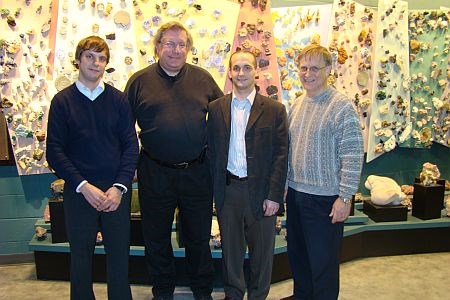By 2010, Kelly Lake may be the site of a brand new technologically advanced Vale Inco mine. Imagine this: no shafts, no head frame, no ropes, crushers, conveyor belts, no toggle replacements, no main ore passes, no haulage trucks, little diesel fumes and no drifts larger than 12-by-12 feet.
Welcome to the Rail-Veyor operated mine. In a city that has hauled ore from its belly for more than 100 years, change is coming. A second feasibility study on Kelly Lake is looking at an all Rail-Veyor option.
Rail-Veyor is similar to the boyhood toy called Hot Wheels Supercharger. It had a little house or station the tracks would run through and two rubber wheels that spun the car forward through loop d'loops, hairpin turns and figure eights.
This was back in the 1960s and truth be told, that was when Rail-Veyor was born in France. It works on the same principles. Instead of having four D-cell batteries and tiny motors, Rail Veyor has two 100-horsepower motors with truck sized tires at various distances that push the train forward on the rails. The idea is when the train comes close to the loading point it slows down, gathers ore or muck without stopping, then takes off from the station fully loaded to transport the material to the mill.
This system, owned independently by Rail-Veyor Technologies Inc. of Sudbury, is being considered by Vale Inco for its Kelly Lake deposit.

The Rail-Veyor project has been researched for more
than three years and is now on its way to be in operation
this year. (Photo supplied)
Part of the feasibility study is comparing a conventional mine layout versus a Rail-Veyor alternative. Although it is too early to make any final determinations the results so far are “extremely encouraging,” says Peter Golde, chief mine engineer for Vale Inco.
The new system would enable Vale Inco to use deep resources while reducing energy consumption by up to 40 sometimes 50 per cent and that includes a reduction in ventilation energy consumption.
“Clearly that would improve the working environment and lessen our dependency on diesel equipment we have today,” Golde says.
It also means a lot of marginal mineralization can become economically viable.
“In Vale Inco's view, this would reduce costs to a point that Sudbury would again become a low-cost producer and survive through any tough economic cycles.”
Golde is considering twin sets of drifts: one for the Rail-Veyor, that would operate in a restricted area, and the other for rubber tire vehicles accessing the mine. He is also looking at loading projects which move away from using load-haul dumpers as haulage mules. Traditionally, these vehicles would go hundreds or thousands of feet hauling the ore right from the drop point. With this new technology, the rail system can go to the ore body reducing emissions, transportation and resource costs.
“We would like to see Rail-Veyor operating 24-7 while looking at best practices and inspection strategies that would maintain a very high level of availability of the system.”
In terms of payback, users would see a quadrupling in the speed of development with respect to new ore bodies. Using Rail-Veyor for ore haulage could increase the return on capital investment by 100 per cent from the typical returns, making projects more attractive.
Mining below shaft bottom has posed numerous financial, safety and environmental challenges, Golde says. For productivity sake, mining houses had to make larger opening for grander pieces of equipment and ventilation, all leading to more infrastructure, higher energy costs and more safety risks to consider.
Sooner, rather than later, Ontario mines will be forced to accept lower diesel particulates and reduce their carbon footprint. With this new technology, they can obtain some of these targets, Golde says.
Ninety-five per cent of the Rail-Veyor system has been manufactured in Sudbury with numerous mining suppliers helping in the project, says Al Ackerman, a former Vale Inco employee and now spokesperson for the Center for Mining Excellence and Innovation (CEMI) where the Rail-Veyor made its public debut. He said there isn't anything in the manufacturing end that Sudbury cannot supply.
Kris Laamanen, president of the family-owned Rail-Veyor Technologies Inc., wants to keep the manufacturing end of it in the North. After all, it would have been what his father, the late Risto Laamanen, wanted.
However, it has to make economical sense, said Kris, who invested the upfront capital along with Vale Inco to research and develop this project near Stobie Mine. Their other family run business, Laamanen Construction, which Kris is also president of, was a part of the development too.
Successful bidders will have to remain competitive, meet production demands, pay attention to quality of service and maintain high standards of workmanship, he said.
“This is not a short term venture,” Kris said who has had an invitation to build this system across the border and overseas.
He has not accessed government funding, “It was never really a plan of my father's.”
Still, one financial investor in the audience says if Sudbury loses this project “they are pooched.”
www.railveyor.com




